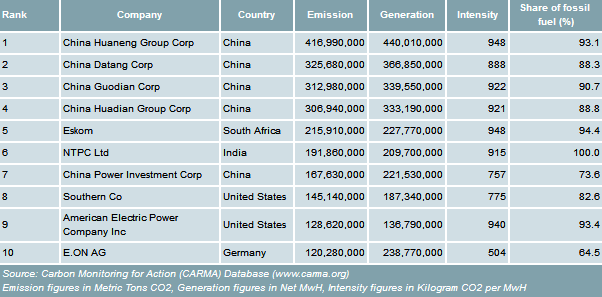India’s state-owned NTPC Ltd ranks as the world’s sixth-largest polluter among 40 large power-generating companies, according to Centre for Global Development (CGD), a Washington-based think-tank. Four Chinese companies are among the top polluters, followed by a South African company at the fifth place.
The findings are part of CGD’s latest database on global carbon emissions, called Carbon Monitoring for Action (Carma). The database says NTPC’s 27 power plants emitted 191 million tonnes of carbon dioxide (CO2) to generate 209.7 billion units (BUs) of electricity in 2009, the latest year for which data has been considered by Carma. Not just this, 20 of the 27 units run by NTPC have been included in the ‘red alert’ category.
The Carma database suggests that in terms of emission intensity (quantum of CO2 emitted per unit of power generated), NTPC ranks eighth among the top 40 power-producing companies globally. NTPC emitted 915 kg of CO2 per megawatt hour (MwH) of power produced.
Carma has said that for India, most of its reported data represents publicly disclosed figures by the government. Data on Indian power plants has been sourced from the Central Electricity Authority (CEA) under the power ministry.
Overall, India is found to be the world’s third-largest CO2 polluting nation, after China with an annual emission of 2,838 mt and the United States with 2,315 mt. India emitted 699.4 mt of CO2 in 2009. Carma has put 568, or 27 per cent, of India’s 2,109 power plants in the ‘red alert’ category. Russia and Japan occupy the fourth and fifth places.
Among Indian states, Uttar Pradesh tops the list with annual CO2 emission of 84.3 mt, followed by Maharashtra with 70 mt, Andhra Pradesh with 65.8 mt, Chhattisgarh with 61 mt, Orissa with 61 mt and Gujarat with 59 mt.

The previous updated version of the database, which was made public in 2008, had described the findings as a ’cause’ of serious concern. Climate scientists had warned that the amount of CO2 and other greenhouse gasses in the atmosphere must be quickly stabilized to avert climate catastrophe, which would hit first and worst in the developing world, with declining agricultural productivity, droughts, floods and rapid sea-level rise hitting densely populated, low-lying regions.

